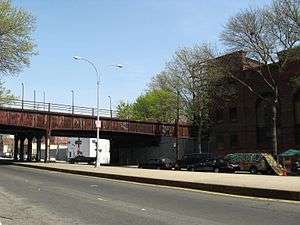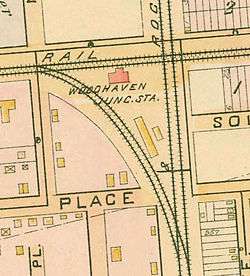Woodhaven Junction station
Woodhaven Junction was a station complex on the Atlantic Branch and Rockaway Beach Branch of the Long Island Rail Road, located at Atlantic Avenue between 98th and 100th Streets in Woodhaven, Queens, New York City.[5] The elevated Rockaway Beach station was closed in 1962 along with the rest of the branch,[1] while the underground Atlantic Branch station was closed and abandoned in 1976.[1]
Woodhaven Junction | |||||||||||||||||||||
|---|---|---|---|---|---|---|---|---|---|---|---|---|---|---|---|---|---|---|---|---|---|
 Former Woodhaven Junction station site | |||||||||||||||||||||
| Location | Atlantic Avenue and 100th Street Woodhaven, Queens, New York | ||||||||||||||||||||
| Coordinates | 40°41′22″N 73°50′39.6″W | ||||||||||||||||||||
| Owned by | Long Island Rail Road | ||||||||||||||||||||
| Line(s) | Atlantic Branch and Rockaway Beach Branch | ||||||||||||||||||||
| Platforms | 4 side platforms (2 on each level) | ||||||||||||||||||||
| Tracks | 4 (2 on each level) | ||||||||||||||||||||
| Other information | |||||||||||||||||||||
| Station code | None | ||||||||||||||||||||
| Fare zone | 1 | ||||||||||||||||||||
| History | |||||||||||||||||||||
| Opened | 1881 (Rockaway Beach, elevated)[1][2] 1893/1895 (Atlantic, street-level)[3] | ||||||||||||||||||||
| Closed | June 8, 1962 (Rockaway Beach, elevated) December 1976 (Atlantic, underground) | ||||||||||||||||||||
| Rebuilt | December 28, 1942 (Atlantic, underground)[4] | ||||||||||||||||||||
| Electrified | 1905 | ||||||||||||||||||||
| Services | |||||||||||||||||||||
| |||||||||||||||||||||
History

The station was first opened by the LIRR in the 1880s for the Rockaway Beach Branch (then known as the New York, Woodhaven and Rockaway Railroad),[1][6] and in 1893 for the Atlantic Branch. Beginning in May 1940, both stations were rebuilt when the Atlantic Branch was grade separated and placed in a tunnel. The elevated Rockaway Beach station opened in September 1941, while the underground Atlantic Branch station opened for service on December 28, 1942.[4]
The elevated station, located on a trestle adjacent to 100th Street, was built with two concrete high-level side platforms, with staircases down to the street and the Atlantic Branch on either side of Atlantic Avenue. The underground station's design resembled an Independent Subway station, with tile work of the same design; the name mosaic reads "Woodhaven." South of the elevated station was a two-track wye, curving northwest from the Rockaway branch to merge with the Atlantic branch west of its station at about 96th Street.[4][7]
In the early expansion plans of the city's Independent Subway System in the 1930s, the Rockaway Beach Branch was planned to be absorbed into the new subway, which would have turned the Woodhaven elevated station into a stop on the IND Queens Boulevard Line or a new Queens crosstown line.[8][9][10] In 1950, the Rockaway Beach Branch south of the Howard Beach station had closed after the trestle on Jamaica Bay between The Raunt and Broad Channel Stations was destroyed by a fire. The city purchased the entire line in 1955, but only the portion south of Liberty Avenue was reactivated for subway service.[11] Ridership declined on the remaining portion of the LIRR Rockaway Beach Branch, and fewer trains were scheduled to stop at Woodhaven on the Atlantic Branch.[1] Passengers who would normally use the station had to ride buses to the next nearest stations. The elevated station of the Rockaway Beach Branch closed first on June 8, 1962, along with the rest of the Rockaway Beach Branch.[1][12][13] The underground station of the Atlantic Branch closed in 1976.[1]
Woodhaven Junction is one of two stations on the abandoned Rockaway Beach Branch still standing (the other being Ozone Park),[1][12] while the underground Atlantic Branch station is still visible from passing trains. The now-abandoned LIRR substation is present on the south side of Atlantic Avenue west of the elevated line.[1] The northern staircases to the elevated station are still visible. The former track junction and part of the Rockaway Branch right-of-way south to 97th Avenue has been paved over and is used as a school bus depot for the Logan Bus Company; the ramp and tunnel portal of the wye have been filled in.[7]
Station layout
| 1F Former Rockaway Branch platform |
Side platform, not in use | |
| Northbound | Trackbed | |
| Southbound | Trackbed | |
| Side platform, not in use | ||
| G | Street Level | Exit; underpass |
| B1 Former Atlantic Branch platform level |
Side platform, not in service | |
| Westbound | ← Atlantic Branch (City Terminal Zone) does not stop here (East New York is the next operating passenger stop) | |
| Eastbound | Atlantic Branch (City Terminal Zone) does not stop here (Jamaica is the next operating passenger stop) → | |
| Side platform, not in service | ||
References
- Bresiger, Gregory (July 18, 2012). "The Trains Stopped Running Here 50 Years Ago". qgazette.com. Queens Gazette. Retrieved July 3, 2015.
- Bob Emery Maps; Woodhaven Junction to Ozone Park (Unofficial LIRR History Site)
- "LIRR Station History (TrainsAreFun.com)". Archived from the original on April 8, 2010. Retrieved February 7, 2010.
-
- "NEW RAIL TUNNEL TO OPEN MONDAY; First Trains for Public to Run in the Underground Route in Atlantic Ave" (December 26, 1942). New York Times Company. December 26, 1942. Retrieved April 23, 2015.
- "ATLANTIC AVE. TUBE OPEN; First Long Island Train Passes Through at 2:47 A. M." (December 28, 1942). New York Times Company. December 28, 1942. Retrieved April 23, 2015.
- "Tunnel Opened on Atlantic Avenue for L.I. Trains; Project Eliminates 20 Hazardous Grade Crossings in Its Run" (PDF) (December 31, 1942). Leader Observer (Queens/Brooklyn, NY). December 31, 1942. p. 1. Retrieved April 23, 2015.
- "First Completed Atlantic Ave. Tube Job Is Inspected: Commissioners Tour Woodhaven Section in 24 Million Project". Brooklyn Daily Eagle. September 10, 1941. p. 3. Retrieved August 18, 2015.
- "Transit Officials Inspect New Tube Under Atlantic Avenue". Brooklyn Daily Eagle. December 30, 1941. p. 3. Retrieved August 18, 2015 – via Newspapers.com.
- "Auction Sale at Rockaway Beach: Tuesday, May 20, 1884". Brooklyn Daily Eagle. May 10, 1884. p. 3. Retrieved August 18, 2015 – via Newspapers.com.
- "Logan Bus Company" (PDF). LaGuardia Community College. Office of the Mayor of New York City. 1998. Retrieved August 18, 2015.
- Roger P. Roess; Gene Sansone (August 23, 2012). The Wheels That Drove New York: A History of the New York City Transit System. Springer Science & Business Media. pp. 416–417. ISBN 978-3-642-30484-2.
- "City Board Votes New Subway Links". The New York Times. March 19, 1937. Retrieved July 3, 2015.
- Martin, Douglas (November 17, 1996). "Subway Planners' Lofty Ambitions Are Buried as Dead-End Curiosities". nytimes.com. The New York Times. Retrieved June 27, 2015.
- Freeman, Ira Henry (June 28, 1956). "Rockaway Trains to Operate Today" (PDF). nytimes.com. The New York Times. Retrieved June 29, 2015.
- Dunlap, David W. (July 30, 2014). "Clashing Visions for Old Rail Bed (Just Don't Call It the High Line of Queens)". nytimes.com. The New York Times. Retrieved July 3, 2015.
- "An Era Ends at 6:09: Last Train Rides Forgotten Spur". Long Island Star-Journal. Fultonhistory.com. June 8, 1962. p. 11. Retrieved August 18, 2016.
External links
| Wikimedia Commons has media related to Woodhaven Junction (LIRR station). |